Strength and Conditioning for Flexible Joints
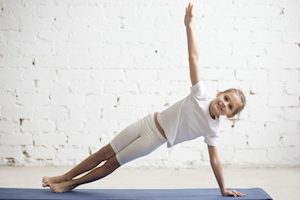
Most children are flexible and some more so than others. Most children will become less supple as they get older, but a small percentage will remain flexible.
Many people with increased flexibility do not experience any significant difficulties; in fact, in many situations (i.e. sportspeople, dancers etc.) flexibility can have positive advantages.
However, some people experience difficulties with symptoms which are understood to be related to having increased flexibility.
These problems are often related to poor muscle strength, poor muscle stamina, muscle tightness and poor control of joint movement and not the flexibility itself.
Common parental concerns
In early development children may initially take longer to achieve crawling, walking, and running. Other frequent findings are:
- Clumsiness and frequent falls
- Flat feet
- Clicky joints
- Tiredness
- Reluctance to walk longer distances
- Pain
- Difficulty with handwriting, dressing or holding a knife and fork.
What can I do to help?
A child who is flexible and does not have any symptoms does not require any management or activity modification. Some of the symptoms of flexibility are understood to be related to weaker or tighter muscles and this muscular deconditioning and instability causes the muscles to have to work even harder. It is therefore particularly important to focus on being healthy, strong, and fit.
The stronger and fitter your child is, the better for their symptoms and general well-being. Supportive footwear such as trainers which provide shock absorbance and are lace up/ buckle shoes support the whole foot. Also ensuring that your child maintains a healthy living weight as this can limit excessive stress through muscles and joints.
Encourage normal everyday activities and play, for example:
- Swimming
- Cycling
- Play in parks
- PE
- Dance
Pain management
- Pacing (Spreading activities out throughout the day). If your child is experiencing muscle pain after exercise, this can be normal, and they should not stop all activity but breakdown or separate tasks to help complete them. Pacing makes activities more achievable enabling them to be completed in manageable chunks without increasing pain. Encourage activities over the week consistently to help build up fitness and strength.
- Hot water bottle/ warm bath. Aches and pains associated with hypermobility are usually a result of muscle fatigue, not damage or injury. A warm bath or a hot water bottle may help.
- Please visit our Pain and Fatigue advice page for further information.
Exercises for children with flexible joints
Hands
Ball grip squeeze
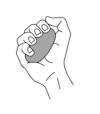
Using a tennis ball/rolled up socks, squeeze the ball and hold this position for five seconds, relax and repeat five times.
Repeat daily .
Resisted thumb extension
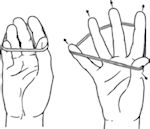
Using an elastic band around your thumb and fingers, open your thumb to increase the resistance of the band. Hold this position for five seconds, relax and repeat five times.
Repeat daily
Exercises to Improve Fine Motor Control
Using Sponges and face cloths
- Using Sponges and face cloths
- Let a sponge or cloth absorb water then wring it out into another container. Count how many times your child has to squeeze out the water to fill the container.
- Half fill two containers with coloured water (using food colouring). Use a sponge or cloth to transfer some of the water from one container to the other – encourage your child to look and see what colour they have made.
- Use rookie sticks (learner chopsticks), tweezers or salad tongs to pick up items such as pieces of cotton wool, or straws. See how many different objects they can pick up. Ask your child to try picking them up at one end of the room and carrying them in the tweezers to the other end of the room before putting them down.
- Using Playdoh or Theraputty
- Hide marbles in the playdoh/putty then kneed it. See if your child can find the marbles again.
- Squash, squeeze, pinch and poke the playdoh/putty to model shapes.
- Make balls by rolling a small piece of playdoh between flat palms in a circular motion. Also get them to try making the balls by rolling the playdoh between the tips of their thumb and index finger.
- Squeeze it into a big ball
- Roll the playdoh into a long snake. Pinch the back of the snake with index finger and thumb (making sure their finger joints don’t bend the wrong way). Alternatively they can roll the end to a really fine point by using just their finger.
- Poke a hole in the playdoh/putty with the index finger. Get your child to squeeze all their fingers and thumb (of one hand) into the hole and then to try and spread their fingers wide apart and so stretching a big hole in the playdoh/putty.
- Roll out a long thin sausage. Wind it round to make a basket. Roll small balls to make ‘eggs’ for the basket.
- Make a pancake by patting a ball between the palms of their hands, or between the palm of one hand and the table surface.
- Using a hole punch: hold the hole punch in one hand and punch holes round a cardboard rectangle (use cereal packets to make the rectangle). Once you r child can do this, try with thicker pieces of card. They can then turn the rectangle into a picture frame, bookmark or picture by sewing and decorating the holes.
- Using bubble wrap: pop bubble wrap using a variety of different grasps: pinch between finger and thumb, two fingers and thumb, use whole hand. See how long it takes to pop all the bubbles.
- Using string: Tie 2 or 3 knots in a piece of string or rope and see how long it takes your child to undo the knots. (Start off with knots that aren’t too tight). Try using different thickness string and rope.
- Using an elastic band
- Ask your child to wind the band in and out of their fingers, so that it is at the top of their fingers. Then ask them to spread their fingers open 20 times and repeat this 3 times.
- Wind the band around their index finger and thumb once or twice depending on the size of the band. See if they can spread/open their index finger and thumb 20 times and repeat 3 times.
- Ask your child to bunch their fingers and thumb together. Put the band over the fingers and thumb near the tips. See if your child can pull their fingers and thumb apart 20 times and repeat this 3 times.
- Loop small elastic bands around 2-4 fingers and ask your child to try to spread their fingers apart to stretch the elastic band. Try this with both hands.
- Using clothes pegs
- Lay 15 pegs out on the table with a cardboard box and timer. See how long it takes your child to squeeze the pegs open and put them on to the box.
- Use clothes pegs to pick up small items like cotton wool or paper balls. Once they can pick them up with the clothes pegs, time how long it takes them to pick up 10 items and drop them in a tub/bowl.
- Use clothes pegs to help hang up washing or peg up pictures. Use coloured pegs to peg up a sequence of colours and then copy the pattern. When squeezing the pegs, make sure your child is not letting the joints of their fingers
- Using a water sprayer/water pistols
- Fill a water sprayer with 20ml of water. Time how long it takes them to squirt out all the water. Gradually increase the amount of water in the sprayer.
- Water plants using a water sprayer to water plants.
- Use a water sprayer filled with paint to paint a design on paper (best done outside).
- Chalk a picture on the patio and then use a water sprayer to wash it off.
- Tie up a balloon or other target and try to hit the target with a spray of water
Shoulders
Shoulder stabiliser
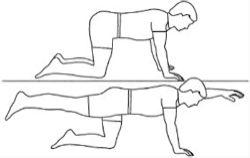
(This exercise also helps to increase the stability around your hip and lower back/abdominal muscles).
Position yourself into a four-point kneeling position. Think about keeping your hip and shoulders level.
Start with trying to lift one arm in front of you and then with the opposite leg. Repeat 10 times, x 3 sets, 3xweekly.
Plank
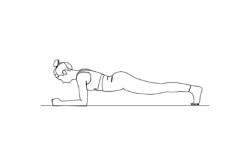
This exercise also helps to increase the stability around your hip and lower back/abdominal muscles).
Start lying onto your tummy. Bend your elbows and place them directly under your shoulders. Keep your back straight and do not let your tummy drop to the floor (start on your knees if it is too hard). Keeping your back straight and lift your body off from the floor.
Hold for 10seconds, x 3 sets, 3x weekly– progress to a 30second hold.
Lower Limb
Bridge
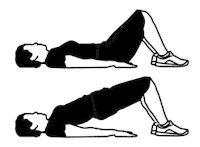 Lie on your back with your arms by your side. Keep a small gap between your knees. Squeeze your bottom muscles and lift your hips off the floor Keep your back straight and not arched. Hold for 5 seconds; repeat 5-10 times x2, 3x weekly.
Lie on your back with your arms by your side. Keep a small gap between your knees. Squeeze your bottom muscles and lift your hips off the floor Keep your back straight and not arched. Hold for 5 seconds; repeat 5-10 times x2, 3x weekly. Wall squat
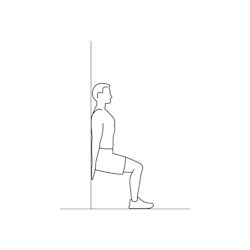 Stand with your back against the wall and feet away from the wall. Slide down the wall until you are in a chair position. Push through your feet to stand up straight again. Do not lock your knees out in standing. Aim 5-10 repetitions x2, 3xweekly.
Stand with your back against the wall and feet away from the wall. Slide down the wall until you are in a chair position. Push through your feet to stand up straight again. Do not lock your knees out in standing. Aim 5-10 repetitions x2, 3xweekly.
Balance exercise
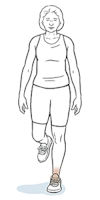 Practice standing on one leg. Aim for 30 seconds without losing your balance.
Practice standing on one leg. Aim for 30 seconds without losing your balance.Repeat daily.
To progress- play throw and catch whilst in this position.
Quadriceps stretch
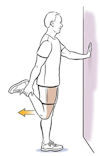
Pull your heel towards your bottom (try to keep your knee towards the floor). Feel a stretch into your thigh. Hold for 30seconds and then relax.
Repeat daily.
Hamstring stretch
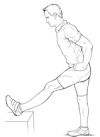 Standing, place one heel up onto a chair or stall in front of you. Keep your knee straight in the elevated leg. Feel a stretch behind your leg and knee. To increase this stretch gently bend your trunk forwards. Hold for 30 seconds and then relax.
Repeat daily.
Standing, place one heel up onto a chair or stall in front of you. Keep your knee straight in the elevated leg. Feel a stretch behind your leg and knee. To increase this stretch gently bend your trunk forwards. Hold for 30 seconds and then relax.
Repeat daily.
Calf stretch
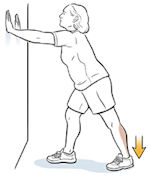 Stand facing a wall, place, with the toes of your front foot touching the wall. Keep the heel of your front foot down and bend your knee to touch the wall. Make sure your knee goes over your toes and your feet face forwards. If this starts to get too easy move your front foot aware from the wall slightly and repeat. You will feel a stretch down your calf. Hold for 30 seconds and then relax.
Repeat daily.
Stand facing a wall, place, with the toes of your front foot touching the wall. Keep the heel of your front foot down and bend your knee to touch the wall. Make sure your knee goes over your toes and your feet face forwards. If this starts to get too easy move your front foot aware from the wall slightly and repeat. You will feel a stretch down your calf. Hold for 30 seconds and then relax.
Repeat daily.At what point will these exercises start to make a difference?
The above exercises can assist with managing symptoms at home. We would expect some muscle aching around the exercised areas when completing the exercises and this might take 24 to 48hours to resolve.
When starting the exercises remember to build them up slowly and progress the number of repetitions as you feel you are getting stronger and more confident. Sometimes symptoms persist for longer, but this doesn’t always mean there is something seriously wrong. It can take on average 12 weeks to build muscle strength when completing exercises on a regular basis (3-4 times a week)?
When to Seek Professional Help
Most children and young people’s pain and difficulties will improve with the measures listed above and for the majority flexibility is unlikely to cause problems in the future providing they remain fit and strong.
Please speak to your GP about a referral to paediatric physiotherapy if you have tried the exercises and strategies on this page and:
- Your child experiences persistent lower limb pain, difficulty walking or participating in activities, or if the pain affects their daily life.
- Your child is experiencing recurrent trips or falls
- Your child experiences any swelling
For more information please see this informative leaflet produced by the Association of Paediatric Chartered Physiotherapists APCP: Hypermobility and Hypermobility Spectrum Disorder
Last updated10 Sep 2025

